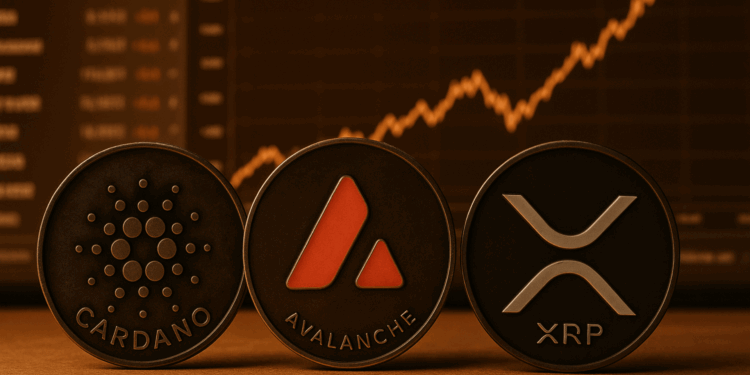- Cardano (ADA): Recognized as a “mature” crypto under U.S. law, with ETF potential, scaling upgrades, and global adoption pilots.
- Avalanche (AVAX): Subnets + token burns make it enterprise-ready with built-in scarcity; partnerships with AWS, Shopify, and governments boost growth.
- Ripple (XRP): Post-SEC clarity, Ripple is pushing to be the first regulated crypto bank, with XRP at the center of global real-time settlements.
Finding altcoins with real fundamentals under a dollar is rare these days. The market is full of meme tokens and short-lived hype coins, but every so often, a few strong contenders slip under the radar. In 2025, three projects in particular—Cardano (ADA), Avalanche (AVAX), and Ripple (XRP)—stand out. They’re not just speculative plays. They’re backed by billion-dollar ecosystems, growing adoption, and upcoming catalysts that could change the way crypto integrates into the global economy.
While most retail investors chase the latest meme pump, these coins are slowly building the foundations of the next wave of adoption. With regulatory clarity, institutional partnerships, and new upgrades all on the horizon, they may be some of the best asymmetric opportunities left under a dollar. Let’s dive into what makes each of these altcoins a sleeper giant.
Cardano (ADA) – From Academic Roots to Institutional Spotlight
Cardano has always stood out for its research-heavy, peer-reviewed approach, but 2025 marks a turning point. Under the new Clarity Act, ADA was officially recognized as one of the three “mature” cryptocurrencies alongside Bitcoin and Ethereum. That’s a big deal—it clears away the legal fog and gives institutions confidence to finally engage with ADA without fear of regulatory backlash. Spot ETFs tied to ADA are now a real possibility, opening the floodgates for capital inflows.
On the technical side, Cardano is gearing up for major upgrades. Hydra promises to unlock scaling potential, Midnight introduces privacy-enabled smart contracts, and new whispers about bridging Bitcoin to Cardano could open massive cross-chain use cases. The project also continues to expand globally, with government-backed adoption pilots across Africa and Asia, and real-world asset tokenization initiatives quietly stacking up.
Despite all this, ADA still trades under $0.90. It’s sitting at a level that looks like a coiled spring—one catalyst away from breaking out. With ETF momentum, scaling upgrades, and expanding use cases, Cardano might just be the most underestimated large-cap coin in the market right now.
Avalanche (AVAX) – Subnets, Token Burns, and Enterprise Growth
Avalanche is carving out a very different lane than its Layer 1 competitors. Instead of chasing flashy narratives, it has become the go-to chain for scalable, application-specific blockchains. Its subnet architecture has attracted gaming studios, AI platforms, and governments piloting tokenized assets. These aren’t just experiments—the daily transaction count and subnet deployments have been climbing steadily, showing real demand.
Another major advantage? AVAX has a strong deflationary model. Every transaction and subnet creation burns fees, which permanently reduces supply. Millions of AVAX have already been burned, making scarcity an embedded feature of the ecosystem. Avalanche has also launched AvaCloud, a tool that helps enterprises spin up their own subnets—essentially offering a “blockchain-as-a-service” model similar to AWS in cloud computing.
Partnerships give Avalanche even more weight. From Shopify to Alibaba Cloud, AWS, and government-level projects, Avalanche is positioning itself as the infrastructure layer for tokenized real-world economies. Trading under $25, AVAX is still recovering from its bear market lows, and with an ETF potentially on the horizon, the upside is huge compared to where it’s priced today.
Ripple (XRP) – From Courtroom Drama to Global Settlement Engine
Ripple’s story has been dominated by its battle with the SEC for years, but that cloud is finally lifting. With the case largely behind them, Ripple is pivoting to a much bigger vision—building the world’s first fully regulated crypto bank. That goal could put them in direct competition with SWIFT, the backbone of global banking, and position XRP as the fuel for real-time settlement across the world.
The partnerships already in play are massive. Ripple has relationships with banks, governments, and payment networks in nearly every major region. XRP is actively being used for real-world remittances, proving it’s more than just a speculative asset. Now, with regulatory clarity, the road to an XRP ETF looks clear. That would invite institutional flows and cement XRP’s role in compliant, large-scale finance.
Despite this, XRP still trades around $3.00—a price that feels disconnected from its long-term potential. Ripple’s deflationary token model, paired with its ambition to become the settlement standard for global finance, gives XRP the kind of upside that could easily deliver a 5x–10x return in this bull cycle.
The Bottom Line
Altcoins under $1 rarely come with real adoption, billion-dollar infrastructure, and regulatory clarity. But Cardano, Avalanche, and Ripple are different. These aren’t meme coins—they’re foundational projects with strong communities, ongoing development, and serious institutional interest.
Whether it’s ADA’s ETF potential, Avalanche’s subnet dominance, or Ripple’s banking ambitions, each of these coins represents an asymmetric opportunity at a price point that’s still accessible to retail investors. They may not stay under $1 for long, but right now, they’re some of the best-positioned assets for anyone building a long-term crypto portfolio in 2025.
The market is chasing hype. Smart money is looking at fundamentals. And that’s why these three undervalued giants could be the real wealth builders of the next bull cycle.














